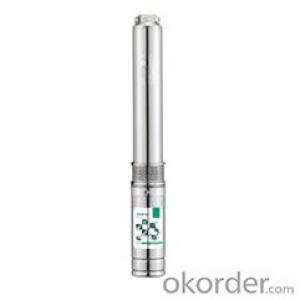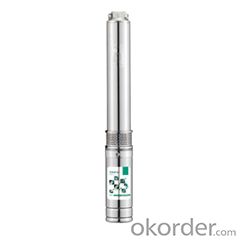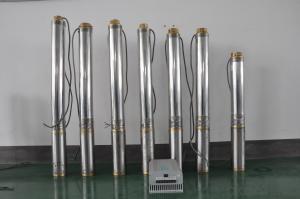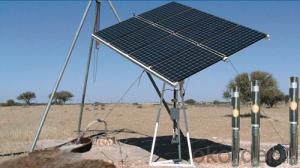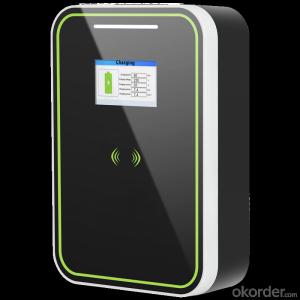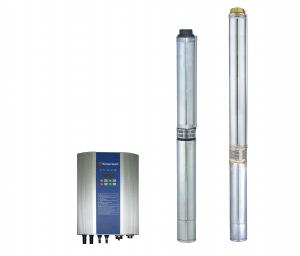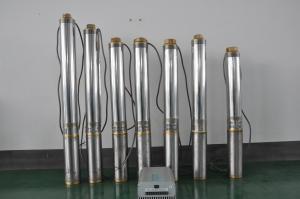4TSC SOLAR PUMP stainless steel CE, solar panel
- Loading Port:
- Shanghai
- Payment Terms:
- TT OR LC
- Min Order Qty:
- 50 pc
- Supply Capability:
- 100000 pc/month
OKorder Service Pledge
OKorder Financial Service
You Might Also Like
1.APPLICATION AREA:This project products are mainly used in dry region for irrigation of agriculture, It can be used for drinking water and
living water. The living condition could be much improved. It also can be used for fountains.2.MATERIAL OF PARTS:Outlet: stainless steel
Pump body: stainless steel
Motor body: stainless steel
Bearing: C&U
3.ADVANCED TECHNOLOGY:1.Application innovation
Compared with the traditional alternating current machine, the efficiency is improved 25% by the permanent magnetism, direct current, brushless, non-sensor motor.
2.Technics innovation
Adopt double plastic package for rotor and stator, motor insulation≥300MΩ, the motor security was much improved.
3.Structure innovation
Oil filling, convenient installation and environmental protection4.HIGHLIGHTSa.Energy-saving and environment-protected green products
b.High technique products adopting MPPT and DSP chip technique.
c.100% copper wire, cold-rolled silicon steel sheet
d.CE certificate
e.Advanced three phase brushless DC motor
f.Stainless steel 316 screws
g.3 years warranty5.PRINCIPLE OF OPERATION:Solar panel collects sunlight→DC electricity energy → solar controller(rectification,stabilization,amplification,filtering)→available DC electricity→(charge the batteries)→pumping water6.ADVANTAGES OF SOLAR PUMP SYSTEM:A.It is easier and more widely used than any other dynamoelectric driven pumps.
B.It is more economical and more environmentally friendly.7.MODEL SELECTION:a.The power of solar panel = power of pump ×1.3
The voltage of solar panel = the voltage of pump
The controller should be matched
b.Select the batteries according to the following formulas:
The use hour of battery =
The battery capacity ÷(the machine power÷the battery voltage)×0.6 For example,the machine power is 200W, the battery
capacity is 100AH,the voltage is 12V,and the battery is fully charged,then the use hour is:100÷(200÷12)×0.6=3.6hours
c.The battery capacity=
the use hour ÷0.6×(the machine power÷the battery voltage) For example,the machine power is 200W,the battery voltage
is 12V,and the battery need to be used for 3.6hours,then the battery capacity is:3.6÷0.6×(200÷12)=100AH
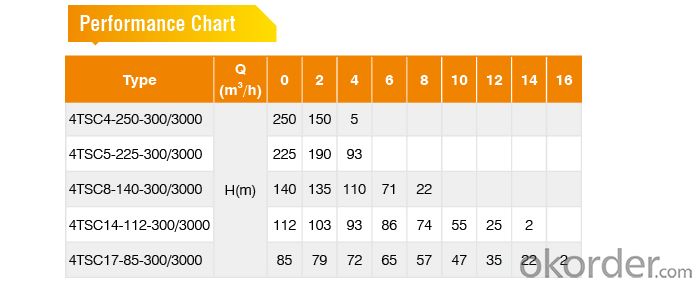

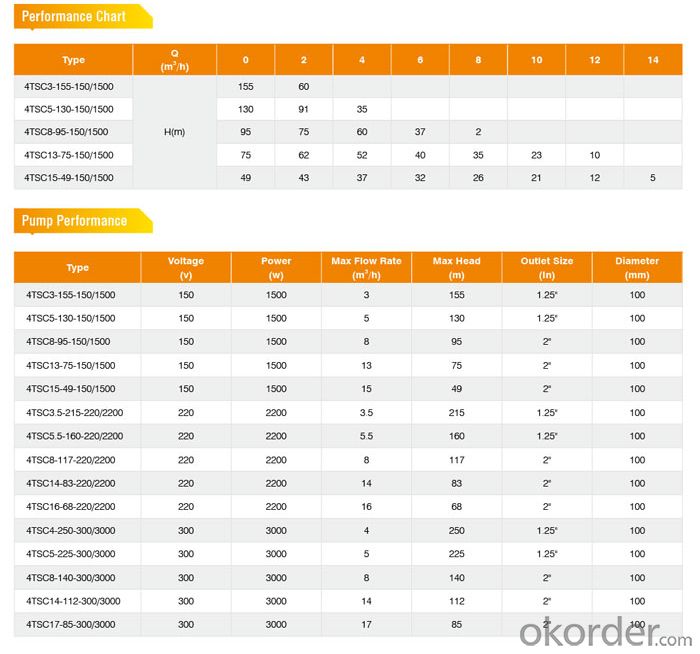
- Q:Can a solar pump be used for water supply in green buildings or eco-resorts?
- Yes, a solar pump can definitely be used for water supply in green buildings or eco-resorts. Solar pumps are an environmentally friendly and sustainable solution as they rely on solar energy to power the pumping mechanism. This reduces the carbon footprint and dependency on fossil fuels. Additionally, solar pumps can be integrated with rainwater harvesting systems to further enhance water conservation efforts in these eco-friendly establishments.
- Q:How do I calculate the total head or lift required for a solar pump system?
- In order to determine the total head or lift needed for a solar pump system, several factors should be taken into consideration. The following steps will guide you through the calculation process: 1. Calculate the total dynamic head (TDH): The TDH is the combined vertical and horizontal distances that the water must be pumped. To calculate the TDH, measure the vertical distance from the water source to the highest discharge point and add it to the horizontal distance between the source and discharge location. Additionally, factor in the frictional losses caused by the pipe's diameter and length. 2. Evaluate the pressure head: The pressure head refers to the vertical distance that the water needs to be lifted. Measure the vertical distance between the water source and the highest discharge point. This measurement will determine the amount of pressure required to pump the water to that elevation. 3. Take into account losses and other factors: Consider any losses caused by the pipe's diameter, bends, elbows, or valves within the system. These losses can be calculated using established equations or data provided by the manufacturer. Additionally, consider factors such as temperature, elevation, and the density of the liquid being pumped, as these can impact the pump's performance. 4. Determine the flow rate: The flow rate represents the volume of water that needs to be pumped within a specific time period. Typically, it is measured in liters per minute (LPM) or gallons per minute (GPM). To determine the flow rate, consider the amount of water required for your specific application, such as irrigation or household needs. 5. Choose an appropriate pump: Once you have calculated the TDH, pressure head, losses, and flow rate, you can select a solar pump that meets these requirements. Refer to the pump manufacturer's specifications and technical data to ensure that the pump can handle the calculated TDH and flow rate. It is important to note that these calculations provide an estimate, and it is recommended to consult with a professional or pump manufacturer to ensure accurate results for your specific solar pump system.
- Q:Are solar pumps suitable for use in cold climates?
- Yes, solar pumps are suitable for use in cold climates. They can continue to operate efficiently even in freezing temperatures, and with proper insulation and protection, they can withstand harsh winter conditions. Additionally, the use of solar energy ensures a sustainable and cost-effective solution for pumping water in cold climates.
- Q:Can a solar pump be used in areas with high salinity water?
- Yes, a solar pump can be used in areas with high salinity water. Solar pumps are designed to operate in a variety of water sources, including those with high salinity levels. However, it is important to consider the specific requirements and compatibility of the solar pump with the salinity levels in order to ensure proper functioning and longevity of the system.
- Q:How does the type of solar panel (monocrystalline, polycrystalline, thin-film) affect the performance of a solar pump?
- The type of solar panel used in a solar pump, whether it is monocrystalline, polycrystalline, or thin-film, can significantly impact its performance. Monocrystalline solar panels are made from a single crystal structure, which allows them to have higher efficiency and better performance in low-light conditions. This means that a solar pump equipped with monocrystalline panels can generate more electricity and operate more efficiently, even under cloudy or shaded conditions. Polycrystalline solar panels are made from multiple crystal structures, resulting in a slightly lower efficiency compared to monocrystalline panels. However, they are still capable of providing adequate power for a solar pump, especially in regions with ample sunlight. Thin-film solar panels are the least efficient of the three types, but they have advantages in terms of flexibility and cost-effectiveness. They can be easily integrated into various surfaces and are less expensive to produce. However, due to their lower efficiency, a solar pump using thin-film panels may require a larger surface area to generate the same amount of power as monocrystalline or polycrystalline panels. In summary, the type of solar panel used in a solar pump affects its performance by influencing its efficiency, ability to generate electricity in low-light conditions, and cost-effectiveness. Monocrystalline panels offer the highest efficiency, while polycrystalline panels strike a balance between efficiency and cost. Thin-film panels are more flexible and cost-effective but have lower efficiency.
- Q:Can solar pumps be used for water supply in remote educational institutions or schools?
- Yes, solar pumps can be used for water supply in remote educational institutions or schools. Solar pumps utilize energy from the sun to power the water pumping system, eliminating the need for grid electricity or fuel. This makes them particularly suitable for remote areas where access to electricity is limited. Solar pumps are cost-effective, environmentally friendly, and require minimal maintenance, making them an ideal solution for providing sustainable water supply in educational institutions located in remote areas.
- Q:Can a solar pump be used in areas with limited access to water monitoring systems?
- Yes, a solar pump can be used in areas with limited access to water monitoring systems. Solar pumps are designed to operate independently, relying solely on solar energy for power. They can be installed in remote locations where traditional water monitoring systems may not be available, providing a sustainable solution for accessing water without the need for extensive monitoring infrastructure.
- Q:Can multiple solar pumps be connected to create a larger water supply system?
- Yes, multiple solar pumps can be connected to create a larger water supply system. By linking the pumps together, they can work in tandem to increase the overall water output. This is commonly done in areas where a single solar pump may not be sufficient to meet the water demand.
- Q:Can a solar pump be used for water supply in remote research stations?
- Yes, a solar pump can be used for water supply in remote research stations. Solar pumps are efficient and reliable, harnessing energy from the sun to power the pump and provide a sustainable water supply. This is particularly beneficial in remote areas where access to electricity may be limited or non-existent. The use of solar pumps reduces dependency on traditional energy sources and helps overcome logistical challenges in providing water to research stations located in remote locations.
- Q:What is the expected energy consumption of a solar pump system over its lifetime?
- The expected energy consumption of a solar pump system over its lifetime is relatively low as it primarily relies on solar energy to operate. The system uses photovoltaic panels to convert sunlight into electricity, which powers the pump. Since solar energy is a renewable and abundant source, the energy consumption is significantly reduced compared to traditional pump systems that rely on fossil fuels or electricity from the grid. Additionally, as solar pump systems do not require fuel or generate greenhouse gas emissions, they provide a more sustainable and cost-effective solution for water pumping needs.
1. Manufacturer Overview |
|
|---|---|
| Location | |
| Year Established | |
| Annual Output Value | |
| Main Markets | |
| Company Certifications | |
2. Manufacturer Certificates |
|
|---|---|
| a) Certification Name | |
| Range | |
| Reference | |
| Validity Period | |
3. Manufacturer Capability |
|
|---|---|
| a)Trade Capacity | |
| Nearest Port | |
| Export Percentage | |
| No.of Employees in Trade Department | |
| Language Spoken: | |
| b)Factory Information | |
| Factory Size: | |
| No. of Production Lines | |
| Contract Manufacturing | |
| Product Price Range | |
Send your message to us
4TSC SOLAR PUMP stainless steel CE, solar panel
- Loading Port:
- Shanghai
- Payment Terms:
- TT OR LC
- Min Order Qty:
- 50 pc
- Supply Capability:
- 100000 pc/month
OKorder Service Pledge
OKorder Financial Service
Similar products
New products
Hot products
Hot Searches
Related keywords
